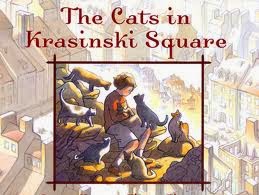Title: The Cats in Krasinski Square
Author: Karen Hesse
Illustrated by: Wendy Watson
Grade Level: 4th-5th grade
Publisher: Scholastic Inc.
Buy it here!
Resources
Summary:
The Cats in Krasinki Square is the story the Ghettos of Warsaw, Poland during World War II. A young girl has escaped the ghetto, but she has not forgotten her friends. This young girl wants to help smuggle food into the ghetto, but the Gestapo finds out. This young girl devises a plan to outwit the Gestapo and get food to her friends in the ghetto. The cats she has befriended hold the secret to her successful plan.
Element #4- Social Movements and Social Change
This book relates to social movements and social change that are encompassed in element four. This story provides a glimpse into the injustice experienced by Jews during WWII. The story also depicts the efforts of people to stop those injustices. Readers will see how the actions of one young lady made a difference. Her bravery and quick wit helped to rescue and deliver food to Jewish people imprisoned in the ghettos of Poland. While many people suffered from religious persecution, countless people risked their lives to help. This story will remind the readers that anyone, even a child, can make a difference. Students will begin to understand that working together can help to create a change or make a difference. Social injustice can be addressed and students will learn from this books that everyone is valuable and we can all work together.
Classroom Activity:
After reading this story, students should have the opportunity to pair/share with their partners. Discussion questions should guide students to understanding the challenges and bravery that the young girl experienced. An activity that would follow would be to have students write a journal response to this prompt: Have you ever seen or experienced an injustice? Tell about an injustice you have seen. Explain how someone could stand up to this injustice or work with others to make a difference.
From their journal responses, the teacher will provide scenarios and students will have the opportunity to role play. Emphasis will given to the idea that everyone can make a difference, and that working with others helps to create change.

No comments:
Post a Comment